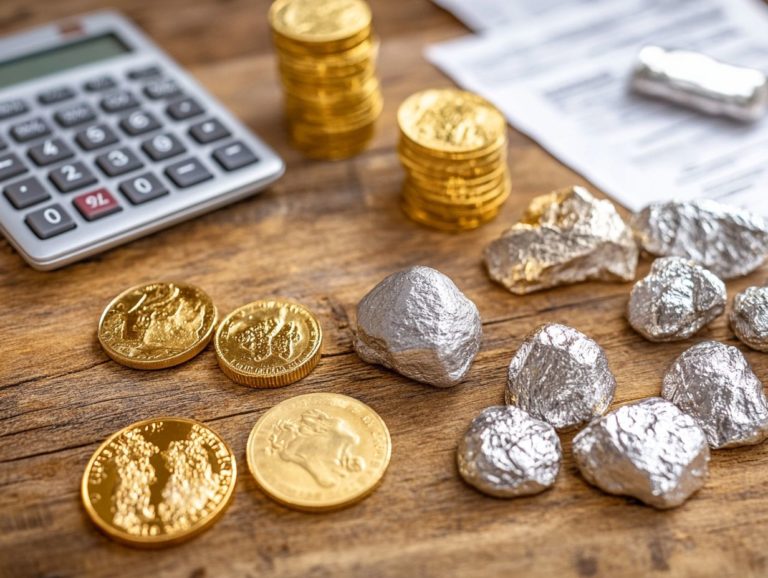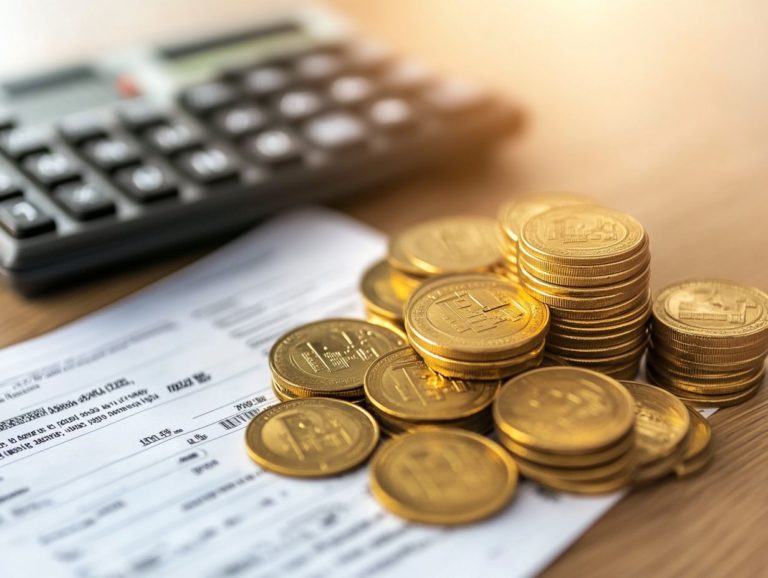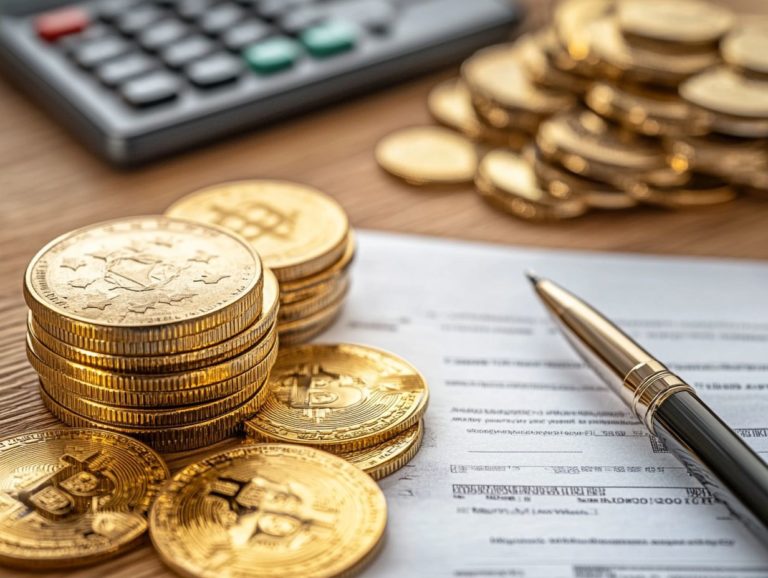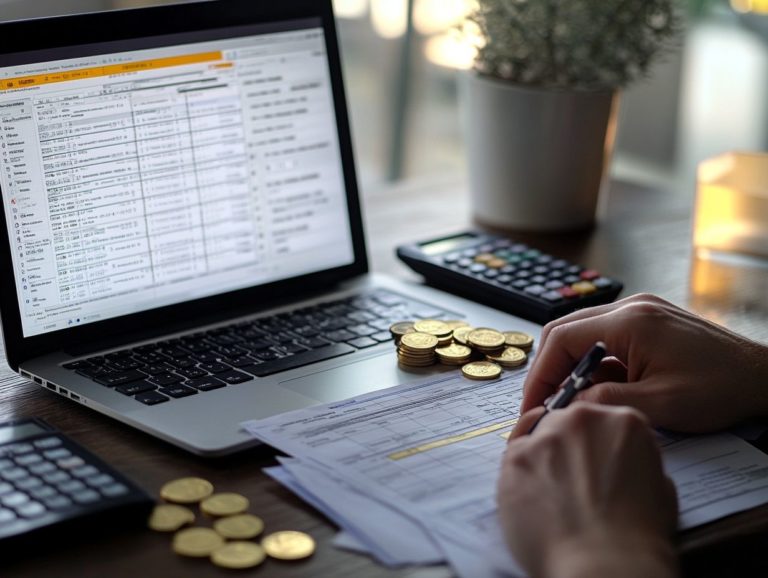Understanding the Tax Code as it Relates to Precious Metals
Navigating the world of taxes can feel daunting, especially when investing in precious metals.
This guide covers key aspects of the tax code and how it affects your buying and selling decisions. You ll learn about capital gains and sales taxes, as well as tax-advantaged options like retirement accounts.
You ll find practical tips to help reduce your tax burden. Whether you re experienced or just starting, this overview gives you the knowledge to make smart financial choices.
Contents
- Key Takeaways:
- Overview of the Tax Code and Precious Metals
- Tax Implications of Buying and Selling Precious Metals
- Capital Gains Tax
- Sales Tax
- Tax-Advantaged Ways to Invest in Precious Metals
- Reporting Requirements for Precious Metals
- Tips for Minimizing Taxes on Precious Metals
- Frequently Asked Questions
- What is the tax code and how does it relate to precious metals?
- What is the difference between capital gains and ordinary income when it comes to precious metals?
- Are all precious metals subject to the same tax treatment?
- What are some tax advantages of investing in precious metals?
- How are taxes on precious metals calculated?
- What are some important tax considerations for buying and selling precious metals?
Key Takeaways:
- Understand the tax code related to precious metals to avoid penalties and maximize profits.
- Buying and selling may affect capital gains and sales tax, so be aware of these factors.
- Explore tax-friendly ways to invest, like retirement accounts and ETFs, to reduce your tax burden.
Overview of the Tax Code and Precious Metals
The tax code governs how taxes are applied to various assets, including precious metals like gold, silver, platinum, and palladium. These assets are popular for wealth accumulation, especially during economic uncertainty.
Understanding the regulations around these metals is essential. This knowledge empowers you to navigate capital gains tax, reporting requirements, and the specific tax implications of your transactions.
Focus on IRS Form 8949 and Schedule D. These forms are critical for compliance and maximizing your investment strategy.
What is the Tax Code?
The tax code is a framework of laws that dictates how taxes are assessed and collected by the IRS. It includes everything from income tax rates to capital gains tax on different investments.
It provides guidelines for income sources like wages, interest, dividends, and capital gains. Each category has its own tax rules, which significantly affect your overall tax burden.
When investing in precious metals, laws dictate their classification and taxation. Gains from sales are often taxed at a higher rate than standard long-term capital gains.
Understanding these details is crucial for compliance and making informed investment choices.
How Does it Relate to Precious Metals?
The tax code specifically regulates precious metals, often classifying them as collectibles. This classification comes with unique tax implications, including different rates for capital gains.
As an investor, knowing this distinction is vital. It can impact your overall returns compared to traditional assets like stocks, which typically face lower tax rates.
Understanding your cost basis, including purchase price and related expenses, is essential for calculating taxable gains. Also, stay updated on exemptions that might help reduce your tax liabilities.
Tax Implications of Buying and Selling Precious Metals
When buying or selling precious metals like gold and silver, be aware of the tax implications involved. Understanding capital gains tax for long-term and short-term gains is crucial as it can significantly affect your investment returns.
Capital Gains Tax
Capital gains tax is the fee you pay on the profits earned from selling precious metals. It’s essential to note that long-term gains are typically taxed at a lower rate than short-term gains.
Understanding these nuances is absolutely vital for you as an investor looking to increase your profits. Long-term capital gains apply to assets you hold for over a year, benefiting from favorable tax rates of 0%, 15%, or 20%, depending on your income level.
In contrast, short-term capital gains from assets held for a year or less are taxed at your regular income tax rate, cutting into your profits from quick sales.
The IRS classifies precious metals as collectibles, imposing a maximum tax rate of 28% on any gains, regardless of how long you’ve held them. Strategic planning can make a real difference in your investment returns.
Sales Tax
When considering the purchase of precious metals, you must consider sales tax. This tax varies by state and may add unexpected transaction fees to your acquisition of physical gold, silver, and other metals.
Understanding how sales tax influences these investments is critical, as it can significantly affect your costs and potential returns. In some states, you might find exemptions for specific purchases, like bullion or coins.
By carefully navigating local laws, you can plan your buys to minimize expenses or capitalize on tax-exempt opportunities. This knowledge not only aids in budgeting but also aligns with your broader investment strategies.
Ultimately, being well-informed gives the power to you to make better decisions in a constantly changing market.
Tax-Advantaged Ways to Invest in Precious Metals
Investing in precious metals through tax-advantaged accounts like a precious metals IRA offers substantial tax benefits. This strategy allows you to grow your wealth without facing immediate tax implications on capital gains.
Retirement Accounts
Retirement accounts, especially precious metals IRAs, present unique tax advantages for you as an investor aiming to incorporate physical gold and silver into your portfolio, allowing for tax-deferred growth.
These accounts enable you to diversify your holdings with not just gold and silver but also with options like platinum and palladium. Setting up a precious metals IRA involves a few essential steps:
- Select an authorized custodian.
- Fund the account.
- Choose eligible metals that meet IRS standards.
Be aware of the regulations surrounding distributions and withdrawals; for example, early withdrawals may incur penalties. By investing in these tangible assets, you can enhance your financial growth and provide a safeguard against inflation.
Exchange-Traded Funds (ETFs)
Exchange-Traded Funds (ETFs) focused on precious metals offer you a savvy investment avenue for gaining exposure to gold, silver, and other metals without the hassles of physical ownership.
Transaction fees for ETFs are usually lower than those for buying and selling individual metals, making this option a financially astute choice. Selling shares in an ETF tends to be more straightforward and can provide distinct tax treatments compared to selling physical metals.
Are you ready to enhance your investment strategy? These funds offer you a more streamlined approach to managing capital gains and fulfilling reporting requirements.
Reporting Requirements for Precious Metals
Understanding the reporting requirements for precious metals is crucial for any investor. Be aware that certain transactions may require you to complete IRS Form 1099-B and adhere to Foreign Bank Account Reporting rules.
This diligence ensures your tax compliance and safeguards your investment’s integrity.
IRS Form 1099-B
IRS Form 1099-B is an essential document for reporting capital gains and losses from selling precious metals. It plays a vital role in helping you follow federal tax laws and ensures that your tax reporting is accurate.
This form requires specific details, including the transaction date, gross proceeds from the sale, and a description of the metal sold. You must also report your cost basis, which is the original value of your investment to determine the profit or loss accurately.
It’s crucial for anyone selling precious metals to gather this information diligently. Failing to report capital gains accurately can lead to significant consequences, including penalties from the IRS that may impact your financial health during tax season.
FBAR Reporting
FBAR reporting, or the Foreign Bank and Financial Accounts Report, is important if you hold precious metals in foreign accounts. This requirement adds complexity to your tax requirements.
Understanding the criteria for this reporting is essential. It applies when the total value of your foreign financial accounts exceeds $10,000 at any time during the year. This requirement is crucial for maintaining transparency and compliance with U.S. tax laws.
If you invest in foreign accounts, especially in precious metals, it s important to recognize that these holdings affect your reporting obligations and may trigger additional regulations. Staying informed and seeking professional guidance is necessary to navigate international finance and tax responsibilities.
Tips for Minimizing Taxes on Precious Metals
You can employ various strategies to minimize taxes on your precious metals investments. Consider timing your sales to benefit from long-term capital gains rates.
By offsetting gains with capital losses, you can effectively reduce your overall tax liability and keep more profits.
Timing Your Sales
The timing of your sales can significantly impact your capital gains tax. Strategic considerations based on market conditions and your individual tax bracket can lead to financial advantages.
Understanding current market trends is vital. Fluctuations in demand and prices for precious metals can create ideal moments for selling. While rising prices may tempt quick action, it s essential to weigh the potential for long-term growth against immediate gains.
You often face a choice between short-term capital gains, taxed at higher rates, and more favorable long-term capital gains. Selecting the right moment to sell affects your tax implications and enhances your overall portfolio performance. This emphasizes the importance of a well-thought-out strategy that considers your financial goals and the broader economic landscape.
Offsetting Gains with Losses
Offsetting gains with capital losses is a savvy tactic as a precious metals investor to lessen your tax burden and improve investment results.
Understanding tax-loss harvesting allows you to strategically sell underperforming assets, balancing out taxable gains from successful investments. For example, if you realize a gain of $10,000 from selling gold and incur a loss of $4,000 from silver, this means you only owe taxes on $6,000 instead of the full $10,000.
You can also carry forward any unused losses to future tax years. This ensures your investment strategy remains efficient and consistently minimizes your tax liabilities. Collaborating with a financial advisor can enhance your approach, tailoring strategies to fit your unique portfolio and optimize returns.
Frequently Asked Questions
What is the tax code and how does it relate to precious metals?
The tax code includes rules about how taxes are collected. It s important for precious metal investments because they are taxed just like other investments.
To optimize your strategies related to precious metals, consider consulting with a tax professional.
What is the difference between capital gains and ordinary income when it comes to precious metals?
Capital gains refer to profits made from selling precious metals for more than their purchase price and have a lower tax rate.
Ordinary income is money you earn regularly and is taxed at a higher rate.
Are all precious metals subject to the same tax treatment?
No, the tax treatment of precious metals varies based on the type of metal and how it’s acquired.
For example, physical bullion is taxed differently than precious metal ETFs.
What are some tax advantages of investing in precious metals?
A great tax advantage of investing in precious metals is the ability to defer taxes through a self-directed IRA.
Certain types of precious metals held for investment may also qualify for a lower capital gains tax rate.
How are taxes on precious metals calculated?
Taxes on precious metals are calculated based on the gain or loss from the sale.
This is determined by subtracting the purchase price from the selling price. Tax rates may vary depending on the holding period and type of metal.
What are some important tax considerations for buying and selling precious metals?
Keep accurate records of all transactions involving precious metals, including purchase and sale prices.
Don’t forget to consult a tax professional to maximize your investment benefits!















